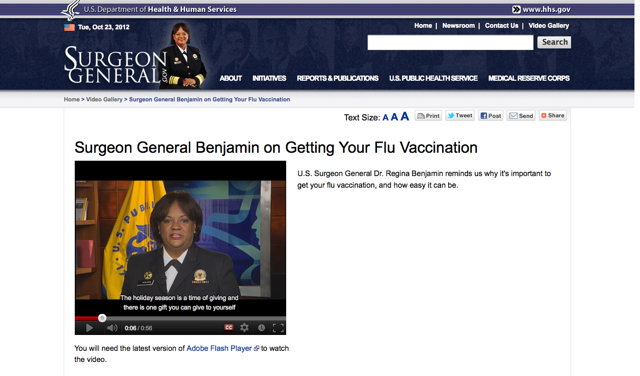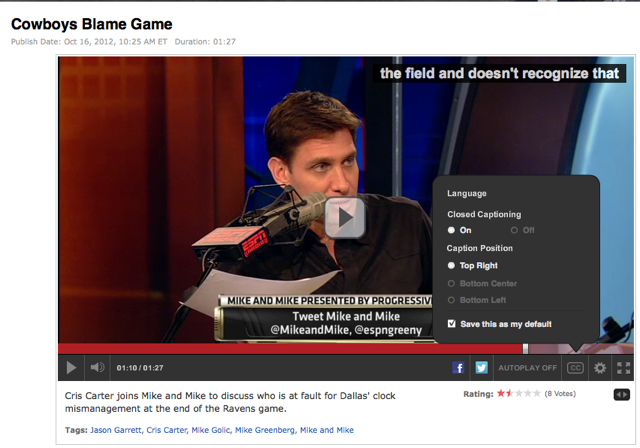Closed Captioning for Streaming Media
Though relatively few websites are required to provide closed captions for their videos, any website with significant video content should consider captioning. Not only does it provide access for deaf and hard-of-hearing viewers, but captions and the associated metadata can dramatically improve video search engine optimization. In this introduction to closed captions, you’ll learn about who needs to caption and who doesn’t (and why you may want to anyway), the available workflows for captioning live events and on-demand files, and a bit about web caption formats and how to marry them to your streaming files.
Let’s jump in.
What Are Closed Captions?
Closed captions enable deaf and hard-of-hearing individuals to access the audio components of the audio/video experience. Closed captions incorporate all elements of the audio experience, including identifying background sounds, the identity of the speaker, the existence of background music, descriptions of how the speaker is talking, and similar information. They are also closed, so they can be disabled for viewers with no hearing disabilities. In contrast, open captions are burned into the video stream and can’t be disabled.
Subtitles are typically implemented to allow viewers to watch videos produced in different languages. Technically, background sounds and other nonvocal audio don’t have to be incorporated into the text description, since subtitles are not designed for the deaf and hard-of-hearing, but these elements are often included. There are many closed captions standards, and several are discussed here. While each has a unique format and structure, the content of all closed caption files is similar, primarily consisting of the textual data and time code information that dictates when it’s displayed.
Who Has to Use Closed Captions?
Two classes of websites caption; those required by law and those who caption voluntarily. Let’s start with those legally required to caption.
Section 508 of the Rehabilitation Act
Four laws create the obligation to caption. Starting with federal agencies, Section 508 1194.24(c) of the Rehabilitation Act (29 U.S.C. 794d) states that “All training and informational video and multimedia productions which support the agency’s mission, regardless of format, that contain speech or other audio information necessary for the comprehension of the content, shall be open or closed captioned.” Beyond these federal requirements, note that states that receive federal funds under the Assistive Technology Act of 1998 must also comply with Section 508 to some degree.
Interestingly, several agencies meet this requirement via YouTube’s captioning. For example, the surgeon general videos available from the Department of Health and Human Services website use YouTube (Figure 1), as do videos from IRS.gov and my home state of Virginia. More on how to use YouTube follows.

Figure 1. Videos from the Department of Health and Human Services website use YouTube’s captioning system to meet the Section 508 requirements.
Twenty-First Century Communications and Video Accessibility Act of 2010
The next class of producers who must add closed captions to their streaming videos are broadcasters, but only with regard to content that has been previously played on TV with closed captions. Specifically, under powers flowing from the Twenty-First Century Communications and Video Accessibility Act of 2010, the Federal Communications Commission issued regulations called the IP Closed Captioning rules in August 2012, which went into effect for some classes of video soon thereafter on Sept. 30, 2012.
That is, prerecorded programming that was not edited for internet distribution must be captioned for the web if it was shown on television on or after Sept. 30, 2012. If content was edited for internet distribution, the deadline is pushed back a year until Sept. 30, 2013. There are several other classes of content covered, including live content published with captions on TV, which must be captioned on the internet by March 30, 2013, and older content that predates the act.
The FCC regulations and interpretations thereof make several points clear. If the content is never shown on television with captions, there is no requirement to caption for streaming. The rules also only relate to full-length programming, not clips or highlights of this programming. This last point explained why ESPN’s full-length shows such as Mike & Mike in the Morning (Figure 2) do have captioning, while none of the highlights that I watched do.

Figure 2. ESPN captions programs that displayed in their entirety on TV.
For more information on the regulations, check out “FCC’s New Closed Captioning Rules Kick Into Gear” on the FCC Law Blog.
Other Closed Captioning Provisions
Several additional federal laws may impose captioning requirements on varying classes of publisher. For example, some authorities opine that Title II of the Americans with Disabilities Act (“Title II”) and Section 504 of the Rehabilitation Act of 1973 (“Section 504”) imposed captioning requirements on public schools, public universities, as well as towns and other municipal bodies. There were conflicting opinions here, though, and I bring it up not to take a position either way but to advise that the obligation may exist. Don’t contact me; contact your attorney.
Related Articles
The introduction of caption transmuxing simplifies deployment by minimizing the number of source files required, though the process is slightly different for live vs. on-demand
27 Nov 2012
Companies and Suppliers Mentioned